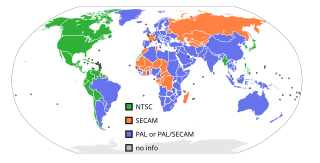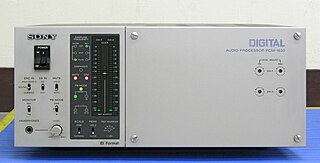
The first American standard for analog television broadcast was developed by National Television System Committee (NTSC) in 1941. In 1961, it was assigned the designation System M.

Phase Alternating Line (PAL) is a colour encoding system for analogue television. It was one of three major analogue colour television standards, the others being NTSC and SECAM. In most countries it was broadcast at 625 lines, 50 fields per second, and associated with CCIR analogue broadcast television systems B, D, G, H, I or K. The articles on analog broadcast television systems further describe frame rates, image resolution, and audio modulation.

In electronics, an analog-to-digital converter is a system that converts an analog signal, such as a sound picked up by a microphone or light entering a digital camera, into a digital signal. An ADC may also provide an isolated measurement such as an electronic device that converts an analog input voltage or current to a digital number representing the magnitude of the voltage or current. Typically the digital output is a two's complement binary number that is proportional to the input, but there are other possibilities.

Telecine is the process of transferring film into video and is performed in a color suite. The term is also used to refer to the equipment used in the post-production process. Telecine enables a motion picture, captured originally on film stock, to be viewed with standard video equipment, such as television sets, video cassette recorders (VCR), DVD, Blu-ray Disc or computers. Initially, this allowed television broadcasters to produce programs using film, usually 16mm stock, but transmit them in the same format, and quality, as other forms of television production. Furthermore, telecine allows film producers, television producers and film distributors working in the film industry to release their productions on video and allows producers to use video production equipment to complete their filmmaking projects. Within the film industry, it is also referred to as a TK, because TC is already used to designate timecode. Motion picture film scanners are similar to telecines.

In signal processing, sampling is the reduction of a continuous-time signal to a discrete-time signal. A common example is the conversion of a sound wave to a sequence of "samples". A sample is a value of the signal at a point in time and/or space; this definition differs from the usage in statistics, which refers to a set of such values.
Broadcasttelevision systems are the encoding or formatting systems for the transmission and reception of terrestrial television signals.
In video technology, 24p refers to a video format that operates at 24 frames per second frame rate with progressive scanning. Originally, 24p was used in the non-linear editing of film-originated material. Today, 24p formats are being increasingly used for aesthetic reasons in image acquisition, delivering film-like motion characteristics. Some vendors advertise 24p products as a cheaper alternative to film acquisition.

The PAL region is a television publication territory that covers most of Europe and Africa, alongside parts of Asia, South America and Oceania. It is named PAL because of the PAL television standard traditionally used in some of those regions, as opposed to the NTSC standard traditionally used in Japan and most of North America.

576i is a standard-definition digital video mode, originally used for digitizing analog television in most countries of the world where the utility frequency for electric power distribution is 50 Hz. Because of its close association with the legacy color encoding systems, it is often referred to as PAL, PAL/SECAM or SECAM when compared to its 60 Hz NTSC-colour-encoded counterpart, 480i.

A PCM adaptor is a device that encodes digital audio as video for recording on a videocassette recorder. The adapter also has the ability to decode a video signal back to digital audio for playback. This digital audio system was used for mastering early compact discs.
The Claws of Axos is the third serial of the eighth season of the British science fiction television series Doctor Who, which was first broadcast in four weekly parts on BBC1 from 13 March to 3 April 1971.
Sample-rate conversion, sampling-frequency conversion or resampling is the process of changing the sampling rate or sampling frequency of a discrete signal to obtain a new discrete representation of the underlying continuous signal. Application areas include image scaling and audio/visual systems, where different sampling rates may be used for engineering, economic, or historical reasons.
This article discusses moving image capture, transmission and presentation from today's technical and creative points of view; concentrating on aspects of frame rates.

PAL-M is the analogue TV system used in Brazil since 19 February 1972. At that time, Brazil was the first South American country to broadcast in colour. Colour TV broadcast began on 19 February 1972, when the TV networks Globo and Bandeirantes transmitted the Caxias do Sul Grape Festival. Transition from black and white to colour, however, was not complete until 1978. Two years later, in 1980, colour broadcast nationwide in Brazil was commonplace.
Scan conversion or scan converting rate is a video processing technique for changing the vertical / horizontal scan frequency of video signal for different purposes and applications. The device which performs this conversion is called a scan converter.
A video standards converter is a video device that converts NTSC to PAL and/or PAL to NTSC. The PAL TV signals may be transcoded to or from SECAM.
Television standards conversion is the process of changing a television transmission or recording from one video system to another. Converting video between different numbers of lines, frame rates, and color models in video pictures is a complex technical problem. However, the international exchange of television programming makes standards conversion necessary so that video may be viewed in another nation with a differing standard. Typically video is fed into video standards converter which produces a copy according to a different video standard. One of the most common conversions is between the NTSC and PAL standards.

Rec. 709, also known as Rec.709, BT.709, and ITU 709, is a standard developed by ITU-R for image encoding and signal characteristics of high-definition television.
Broadcast-safe video is a term used in the broadcast industry to define video and audio compliant with the technical or regulatory broadcast requirements of the target area or region the feed might be broadcasting to. In the United States, the Federal Communications Commission (FCC) is the regulatory authority; in most of Europe, standards are set by the European Broadcasting Union (EBU).
In digital audio, 44,100 Hz is a common sampling frequency. Analog audio is often recorded by sampling it 44,100 times per second, and then these samples are used to reconstruct the audio signal when playing it back.